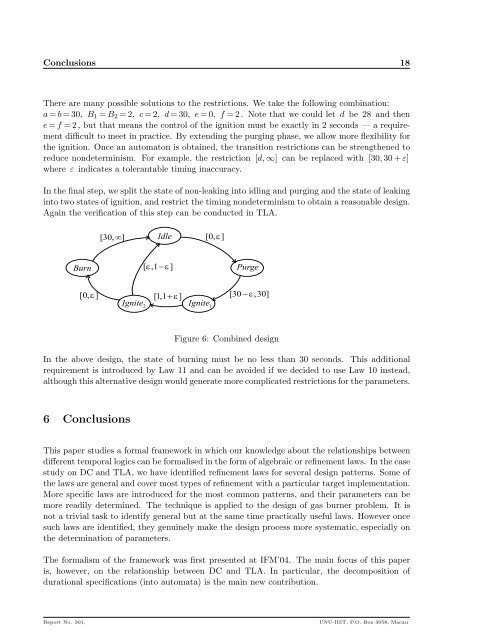IIST and UNU - UNU-IIST - United Nations University
IIST and UNU - UNU-IIST - United Nations University
IIST and UNU - UNU-IIST - United Nations University
Create successful ePaper yourself
Turn your PDF publications into a flip-book with our unique Google optimized e-Paper software.
Conclusions 18<br />
There are many possible solutions to the restrictions. We take the following combination:<br />
a = b = 30, B 1 = B 2 = 2, c = 2, d = 30, e = 0, f = 2 . Note that we could let d be 28 <strong>and</strong> then<br />
e = f = 2 , but that means the control of the ignition must be exactly in 2 seconds — a requirement<br />
difficult to meet in practice. By extending the purging phase, we allow more flexibility for<br />
the ignition. Once an automaton is obtained, the transition restrictions can be strengthened to<br />
reduce nondeterminism. For example, the restriction [d, ∞] can be replaced with [30, 30 + ε]<br />
where ε indicates a tolerantable timing inaccuracy.<br />
In the final step, we split the state of non-leaking into idling <strong>and</strong> purging <strong>and</strong> the state of leaking<br />
into two states of ignition, <strong>and</strong> restrict the timing nondeterminism to obtain a reasonable design.<br />
Again the verification of this step can be conducted in TLA.<br />
Figure 6: Combined design<br />
In the above design, the state of burning must be no less than 30 seconds. This additional<br />
requirement is introduced by Law 11 <strong>and</strong> can be avoided if we decided to use Law 10 instead,<br />
although this alternative design would generate more complicated restrictions for the parameters.<br />
6 Conclusions<br />
This paper studies a formal framework in which our knowledge about the relationships between<br />
different temporal logics can be formalised in the form of algebraic or refinement laws. In the case<br />
study on DC <strong>and</strong> TLA, we have identified refinement laws for several design patterns. Some of<br />
the laws are general <strong>and</strong> cover most types of refinement with a particular target implementation.<br />
More specific laws are introduced for the most common patterns, <strong>and</strong> their parameters can be<br />
more readily determined. The technique is applied to the design of gas burner problem. It is<br />
not a trivial task to identify general but at the same time practically useful laws. However once<br />
such laws are identified, they genuinely make the design process more systematic, especially on<br />
the determination of parameters.<br />
The formalism of the framework was first presented at IFM’04. The main focus of this paper<br />
is, however, on the relationship between DC <strong>and</strong> TLA. In particular, the decomposition of<br />
durational specifications (into automata) is the main new contribution.<br />
Report No. 301,<br />
<strong>UNU</strong>-<strong>IIST</strong>, P.O. Box 3058, Macau
















